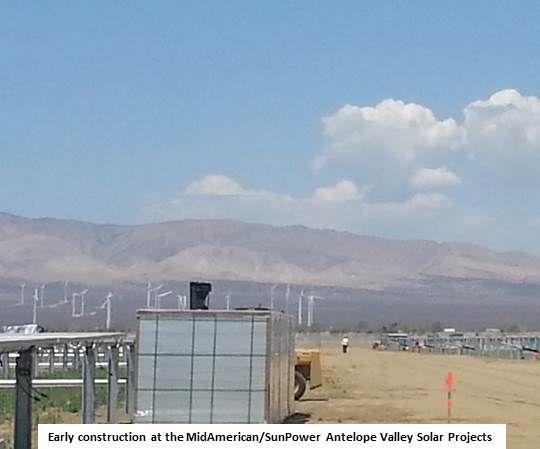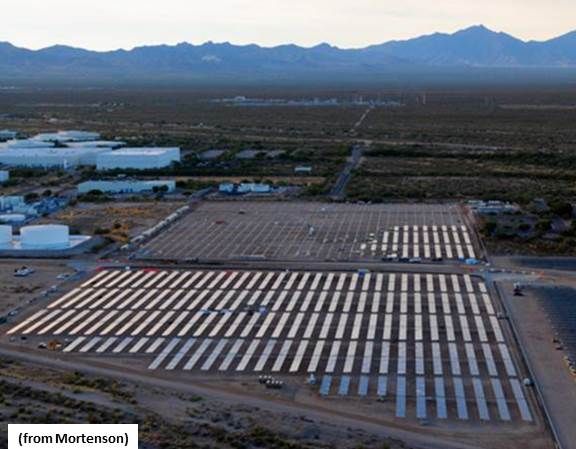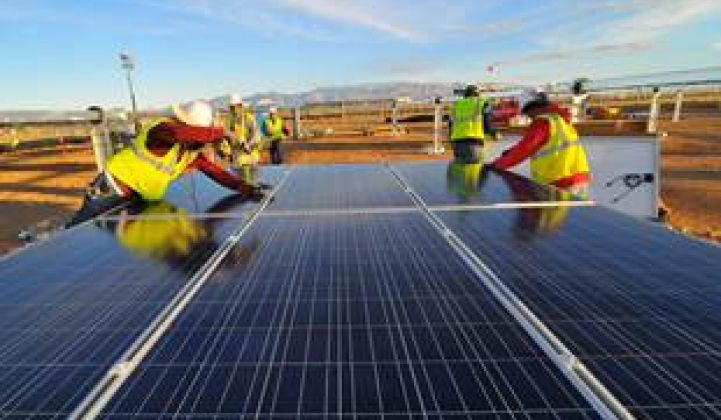The key to building a solar project is understanding the risk. That’s what Mortenson Construction learned when it moved into the sector from wind.
And Mortenson Construction is on its way to winning its bet on solar -- with about 100 solar megawatts built, ongoing work as subcontractor to SunPower on the MidAmerican Solar 579-megawatt Antelope Valley Solar Projects (AVSP), and ground broken on 50 more megawatts.
Other major construction space players are also going solar. Construction giant Bechtel will soon inaugurate the 372-megawatt Ivanpah solar power tower facility for BrightSource Energy. Fluor recently completed the 20-megawatt Copper Crossing PV installation for Iberdrola Renewables and took on other PV and CSP projects.
The top solar engineering, procurement and construction contractors in 2012 were, according to a recent report, First Solar (FSLR), SunEdison (WFR), BELECTRIC, China Power Investment Corporation, and juwi.

Source: GTM Research Utility PV Market Tracker
Mortenson has built over 13,000 megawatts of wind projects since 1995 and is among the top builders in that sector, along with Blattner Energy, Wanzek, White Construction, and RMT.
In 2008, the 59-year-old construction powerhouse was looking to expand its portfolio and identified several renewable energy opportunities as “emerging,” explained Steve Hansen, Director of Business Development for the Solar and Emerging Renewables Group. His team was assigned to study geothermal and solar and saw favorable policies, investor interest and technological developments in the utility-scale solar market.
“On the people side, we organically grew the expertise,” Hansen said. Both the General Manager and the Director of Project Development came from wind operations. They began with cost modeling, then reached out for feedback from wind customers who knew the solar space.
“It was an eighteen-month startup,” Hansen said. The company’s financial strength and stability allowed the solar group to cross the entrepreneurial "valley of death" between business plan and profit.
Not sure where the solar market would go, Mortenson built 60 Stirling engine Sun-Catchers for Tessera Solar in Arizona and the 30-megawatt Cogentrix Alamosa concentrated photovoltaic project in Colorado. As PV’s cost started dropping, the company focused on it, working on small thin film and crystalline silicon jobs and trying out fixed-tilt and tracking mounts. It is now building its fifteenth PV project.
“We have settled into mostly ground-mount PV between 5 megawatts and 500 megawatts, with 20-megawatt to 100-megawatt projects in our sweet spot,” Hansen said. “We haven’t pursued CSP, but that doesn’t mean we wouldn’t shift our focus if the market dictated it.”
The company learned to watch the market closely. “In 2009-2010, we saw a lot of huge PPAs signed for CSP, but we didn’t foresee them getting built. We decided to focus on projects we thought would get built.”
Mortenson also tapped wind customers who were building solar. An early opportunity came from EDF Renewables, for which it built a 1.8-megawatt project in New Jersey. It was eventually chosen to build a 6-megawatt SunPower project in North Carolina in 2009. It was the first project on which Mortenson “self-performed” most of the work, including electrical, racking, and module installation.
“We had discussed with SunPower how using our company could help SunPower reduce its installed costs,” Hansen said. The company "gave us a shot, and we knocked it out of the park, which didn't hurt when the AVSP project came along.”
Mortenson was selected as one of the contractors for AVSP, the biggest fully permitted PV solar power plant in the world.

Important to Mortenson’s success, Hansen said, is the attention to safety and quality in the company’s DNA. “We overlaid guidelines and templates for those and for our lean construction techniques.”
In building a solar project, there are many kinds of risk, Hansen noted, a sentiment with which Dan Biere, Solar and Emerging Renewables Director of Operations, readily agreed.
“Other companies may not invest much time in training their people. To us, that’s a huge risk,” Hansen said. “To mitigate it, we spend a lot of time training people.”
“Our biggest challenge,” Biere said, “and we see it time and again, is on-time delivery of materials. Both solar products and construction materials. We are always under the gun to get procurement done and get materials delivered on time.”
To meet that challenge, he explained, Mortenson does pre-planning, places product orders very early, often under limited authorizations, and uses multiple suppliers.
Hansen’s most important lesson learned, he said, is “don’t promise things you can’t deliver. There are a lot of people in the solar industry who do not follow that fundamental rule.”




